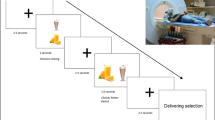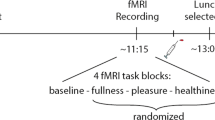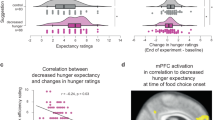Abstract
Objectives:
Excessive weight gain and obesity are currently among the world’s major threats to health. Women show significantly higher rates of obesity and eating disorders relative to men, but the factors contributing to these gender differences remain uncertain. We examined the correlations between regional brain responses to images of high-calorie versus low-calorie foods and self-reported motivational status, including ratings of general appetite, overeating propensity, state hunger and desire for specific foods.
Subjects:
Thirty-eight healthy right-handed adults (22 male; 16 female) ages 18–45 participated. There were no differences between males and females with regard to age or body mass index (BMI).
Results:
Overall, motivational status correlated significantly with activation within the amygdala, insula and orbitofrontal cortex. Regional activation was then used to predict BMI, an indicator of long-term food consumption and energy expenditure. The combined model was significant, accounting for 76% of the variance in BMI for women, whereas the same regions were not predictive of weight status among men.
Conclusions:
Findings suggest that long-term weight status is related to visual responsiveness to calorie-dense food imagery among women.
This is a preview of subscription content, access via your institution
Access options
Subscribe to this journal
Receive 12 print issues and online access
$259.00 per year
only $21.58 per issue
Buy this article
- Purchase on Springer Link
- Instant access to full article PDF
Prices may be subject to local taxes which are calculated during checkout


Similar content being viewed by others
References
Flegal KM, Carroll MD, Ogden CL, Johnson CL . Prevalence and trends in obesity among US adults, 1999-2000. JAMA 2002; 288: 1723–1727.
Ogden CL, Carroll MD, Kit BK, Flegal KM . Prevalence of obesity in the United States, 2009-2010. NCHS Data Brief 2012; 82: 1–8.
Overweight, obesity, and health risk. National task force on the prevention and treatment of obesity. Arch Intern Med 2000; 160: 898–904.
Ogden CL, Carroll MD, Curtin LR, McDowell MA, Tabak CJ, Flegal KM . Prevalence of overweight and obesity in the United States, 1999-2004. JAMA 2006; 295: 1549–1555.
Lewinsohn PM, Seeley JR, Moerk KC, Striegel-Moore RH . Gender differences in eating disorder symptoms in young adults. Int J Eat Disord 2002; 32: 426–440.
Striegel-Moore RH, Bulik CM . Risk factors for eating disorders. Am Psychol 2007; 62: 181–198.
Striegel-Moore RH, Rosselli F, Perrin N, DeBar L, Wilson GT, May A et al. Gender difference in the prevalence of eating disorder symptoms. Int J Eat Disord 2009; 42: 471–474.
Yeo GS, Heisler LK . Unraveling the brain regulation of appetite: lessons from genetics. Nat Neurosci 2012; 15: 1343–1349.
Zeltser LM, Seeley RJ, Tschop MH . Synaptic plasticity in neuronal circuits regulating energy balance. Nat Neurosci 2012; 15: 1336–1342.
Williams KW, Elmquist JK . From neuroanatomy to behavior: central integration of peripheral signals regulating feeding behavior. Nat Neurosci 2012; 15: 1350–1355.
Gregersen NT, Moller BK, Raben A, Kristensen ST, Holm L, Flint A et al. Determinants of appetite ratings: the role of age, gender, BMI, physical activity, smoking habits, and diet/weight concern. Food Nutr Res 2011; 55, doi: 10.3402/fnr.v55i0.7028.
Hooper N, Sandoz EK, Ashton J, Clarke A, McHugh L . Comparing thought suppression and acceptance as coping techniques for food cravings. Eat Behav 2012; 13: 62–64.
Moore CJ, Cunningham SA . Social position, psychological stress, and obesity: a systematic review. J Acad Nutr Diet 2012; 112: 518–526.
Verstuyf J, Patrick H, Vansteenkiste M, Teixeira PJ . Motivational dynamics of eating regulation: a self-determination theory perspective. Int J Behav Nutr Phys Act 2012; 9: 21.
Cornier MA, Salzberg AK, Endly DC, Bessesen DH, Tregellas JR . Sex-based differences in the behavioral and neuronal responses to food. Physiol Behav 2010; 99: 538–543.
Killgore WDS, Yurgelun-Todd DA . Sex differences in cerebral responses to images of high versus low-calorie food. Neuroreport 2010; 21: 354–358.
Lawrence NS, Hinton EC, Parkinson JA, Lawrence AD . Nucleus accumbens response to food cues predicts subsequent snack consumption in women and increased body mass index in those with reduced self-control. Neuroimage 2012; 63: 415–422.
LaBar KS, Gitelman DR, Parrish TB, Kim YH, Nobre AC, Mesulam MM . Hunger selectively modulates corticolimbic activation to food stimuli in humans. Behav Neurosci 2001; 115: 493–500.
Lutter M, Nestler EJ . Homeostatic and hedonic signals interact in the regulation of food intake. J Nutr 2009; 139: 629–632.
Piech RM, Lewis J, Parkinson CH, Owen AM, Roberts AC, Downing PE et al. Neural correlates of appetite and hunger-related evaluative judgments. PLoS One 2009; 4: e6581.
Nederkoorn C, Houben K, Hofmann W, Roefs A, Jansen A . Control yourself or just eat what you like? Weight gain over a year is predicted by an interactive effect of response inhibition and implicit preference for snack foods. Health Psychol 2010; 29: 389–393.
Hofmann W, Friese M, Roefs A . Three ways to resist temptation: the independent contributions of executive attention, inhibitory control, and affect regulation to the impulse control of eating behavior. J Exp Soc Psychol 2009; 45: 431–435.
Batterink L, Yokum S, Stice E . Body mass correlates inversely with inhibitory control in response to food among adolescent girls: an fMRI study. Neuroimage 2010; 52: 1696–1703.
Gruber AJ, McDonald RJ . Context, emotion, and the strategic pursuit of goals: interactions among multiple brain systems controlling motivated behavior. Front Behav Neurosci 2012; 6: 50.
Killgore WDS, Young AD, Femia LA, Bogorodzki P, Rogowska J, Yurgelun-Todd DA . Cortical and limbic activation during viewing of high- versus low-calorie foods. Neuroimage 2003; 19: 1381–1394.
Killgore WDS, Yurgelun-Todd DA . Developmental changes in the functional brain responses of adolescents to images of high and low-calorie foods. Dev Psychobiol 2005; 47: 377–397.
Killgore WDS, Yurgelun-Todd DA . Positive affect modulates activity in the visual cortex to images of high calorie foods. Int J Neurosci 2007; 117: 643–653.
Siep N, Roefs A, Roebroeck A, Havermans R, Bonte ML, Jansen A . Hunger is the best spice: an fMRI study of the effects of attention, hunger and calorie content on food reward processing in the amygdala and orbitofrontal cortex. Behav Brain Res 2009; 198: 149–158.
Killgore WDS, Ross AJ, Kamiya T, Kawada Y, Renshaw PF, Yurgelun-Todd DA . Citicoline affects appetite and cortico-limbic responses to images of high-calorie foods. Int J Eat Disord 2010; 43: 6–13.
Mehta S, Melhorn SJ, Smeraglio A, Tyagi V, Grabowski T, Schwartz MW et al. Regional brain response to visual food cues is a marker of satiety that predicts food choice. Am J Clin Nutr 2012; 96: 989–999.
Murdaugh DL, Cox JE, Cook EW, Weller RE . fMRI reactivity to high-calorie food pictures predicts short- and long-term outcome in a weight-loss program. Neuroimage 2012; 59: 2709–2721.
Killgore WDS, Yurgelun-Todd DA . Body mass predicts orbitofrontal activity during visual presentations of high-calorie foods. Neuroreport 2005; 16: 859–863.
Killgore WDS, Yurgelun-Todd DA . Affect modulates appetite-related brain activity to images of food. Int J Eat Disord 2006; 39: 357–363.
Tzourio-Mazoyer N, Landeau B, Papathanassiou D, Crivello F, Etard O, Delcroix N et al. Automated anatomical labeling of activations in SPM using a macroscopic anatomical parcellation of the MNI MRI single-subject brain. Neuroimage 2002; 15: 273–289.
Maldjian JA, Laurienti PJ, Kraft RA, Burdette JH . An automated method for neuroanatomic and cytoarchitectonic atlas-based interrogation of fMRI data sets. Neuroimage 2003; 19: 1233–1239.
van der Laan LN, de Ridder DT, Viergever MA, Smeets PA . The first taste is always with the eyes: a meta-analysis on the neural correlates of processing visual food cues. Neuroimage 2011; 55: 296–303.
Goddard GV . Functions of the Amygdala. Psychol Bull 1964; 62: 89–109.
Loscher W, Brandt C, Ebert U . Excessive weight gain in rats over extended kindling of the basolateral amygdala. Neuroreport 2003; 14: 1829–1832.
Malkova L, Mishkin M, Suomi SJ, Bachevalier J . Long-term effects of neonatal medial temporal ablations on socioemotional behavior in monkeys (Macaca mulatta). Behav Neurosci 2010; 124: 742–760.
Eippert F, Veit R, Weiskopf N, Erb M, Birbaumer N, Anders S . Regulation of emotional responses elicited by threat-related stimuli. Hum Brain Mapp 2007; 28: 409–423.
Phelps EA, O'Connor KJ, Gatenby JC, Gore JC, Grillon C, Davis M . Activation of the left amygdala to a cognitive representation of fear. Nat Neurosci 2001; 4: 437–441.
Britton JC, Phan KL, Taylor SF, Welsh RC, Berridge KC, Liberzon I . Neural correlates of social and nonsocial emotions: an fMRI study. Neuroimage 2006; 31: 397–409.
Fitzgerald DA, Posse S, Moore GJ, Tancer ME, Nathan PJ, Phan KL . Neural correlates of internally-generated disgust via autobiographical recall: a functional magnetic resonance imaging investigation. Neurosci Lett 2004; 370: 91–96.
Augustine JR . Circuitry and functional aspects of the insular lobe in primates including humans. Brain Res 1996; 22: 229–244.
Morris JS, Dolan RJ . Involvement of human amygdala and orbitofrontal cortex in hunger-enhanced memory for food stimuli. J Neurosci 2001; 21: 5304–5310.
Benuzzi F, Lui F, Duzzi D, Nichelli PF, Porro CA . Does it look painful or disgusting? Ask your parietal and cingulate cortex. J Neurosci 2008; 28: 923–931.
Killgore WDS, Britton JC, Price LM, Gold AL, Deckersbach T, Rauch SL . Neural correlates of anxiety sensitivity during masked presentation of affective faces. Depress Anxiety 2011; 28: 243–249.
Houben K, Havermans RC . A delicious fly in the soup. The relationship between disgust, obesity, and restraint. Appetite 2012; 58: 827–830.
Kringelbach ML, Rolls ET . The functional neuroanatomy of the human orbitofrontal cortex: evidence from neuroimaging and neuropsychology. Prog Neurobiol 2004; 72: 341–372.
Rolls ET . The orbitofrontal cortex and reward. Cereb Cortex 2000; 10: 284–294.
Small DM, Zatorre RJ, Dagher A, Evans AC, Jones-Gotman M . Changes in brain activity related to eating chocolate: from pleasure to aversion. Brain 2001; 124 (Pt 9): 1720–1733.
Grabenhorst F, Rolls ET . Different representations of relative and absolute subjective value in the human brain. Neuroimage 2009; 48: 258–268.
Grabenhorst F, Rolls ET . Value, pleasure and choice in the ventral prefrontal cortex. Trends Cogn Sci 2011; 15: 56–67.
Gearhardt AN, Yokum S, Orr PT, Stice E, Corbin WR, Brownell KD . Neural correlates of food addiction. Arch Gen Psychiat 2011; 68: 808–816.
Holsen LM, Zarcone JR, Thompson TI, Brooks WM, Anderson MF, Ahluwalia JS et al. Neural mechanisms underlying food motivation in children and adolescents. Neuroimage 2005; 27: 669–676.
Volkow ND, Wang GJ, Telang F, Fowler JS, Thanos PK, Logan J et al. Low dopamine striatal D2 receptors are associated with prefrontal metabolism in obese subjects: possible contributing factors. Neuroimage 2008; 42: 1537–1543.
Smucny J, Cornier MA, Eichman LC, Thomas EA, Bechtell JL, Tregellas JR . Brain structure predicts risk for obesity. Appetite 2012; 59: 859.
Nolan-Poupart S, Veldhuizen MG, Geha P, Small DM . Midbrain response to milkshake correlates with ad libitum milkshake intake in the absence of hunger. Appetite 2013; 60: 168–174.
Fuhrer D, Zysset S, Stumvoll M . Brain activity in hunger and satiety: an exploratory visually stimulated FMRI study. Obesity (Silver Spring) 2008; 16: 945–950.
Santos A, Mier D, Kirsch P, Meyer-Lindenberg A . Evidence for a general face salience signal in human amygdala. Neuroimage 2011; 54: 3111–3116.
Kim HJ, Kim N, Kim S, Hong S, Park K, Lim S et al. Sex differences in amygdala subregions: evidence from subregional shape analysis. Neuroimage 2012; 60: 2054–2061.
Bach DR, Behrens TE, Garrido L, Weiskopf N, Dolan RJ . Deep and superficial amygdala nuclei projections revealed in vivo by probabilistic tractography. J Neurosci 2011; 31: 618–623.
LeDoux JE . Emotion circuits in the brain. Annu Rev Neurosci 2000; 23: 155–184.
Frank S, Laharnar N, Kullmann S, Veit R, Canova C, Hegner YL et al. Processing of food pictures: influence of hunger, gender and calorie content. Brain Res 2010; 1350: 159–166.
Gallagher D, Visser M, Sepulveda D, Pierson RN, Harris T, Heymsfield SB . How useful is body mass index for comparison of body fatness across age, sex, and ethnic groups? Am J Epidemiol 1996; 143: 228–239.
Acknowledgements
This research was supported by a USAMRAA grant (W81XWH-09-1-0730).
Author information
Authors and Affiliations
Corresponding author
Ethics declarations
Competing interests
The authors declare no conflict of interest.
Rights and permissions
About this article
Cite this article
Killgore, W., Weber, M., Schwab, Z. et al. Cortico-limbic responsiveness to high-calorie food images predicts weight status among women. Int J Obes 37, 1435–1442 (2013). https://doi.org/10.1038/ijo.2013.26
Received:
Revised:
Accepted:
Published:
Issue Date:
DOI: https://doi.org/10.1038/ijo.2013.26
Keywords
This article is cited by
-
Neuroimaging Investigations of Obesity: a Review of the Treatment of Sex from 2010
Current Obesity Reports (2023)
-
Alterations in Functional and Structural Connectivity of Basal Ganglia Network in Patients with Obesity
Brain Topography (2022)
-
Obesity and brain structure in schizophrenia – ENIGMA study in 3021 individuals
Molecular Psychiatry (2022)
-
Sex/Gender Differences in Obesity Prevalence, Comorbidities, and Treatment
Current Obesity Reports (2021)
-
Association between body mass index and subcortical brain volumes in bipolar disorders–ENIGMA study in 2735 individuals
Molecular Psychiatry (2021)



